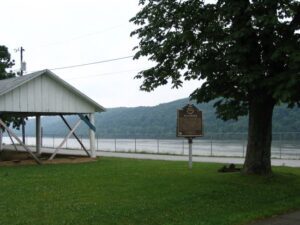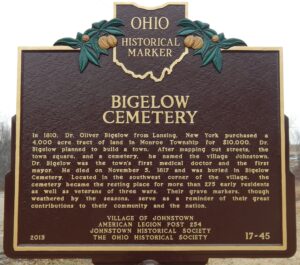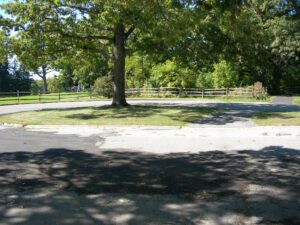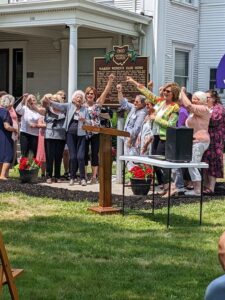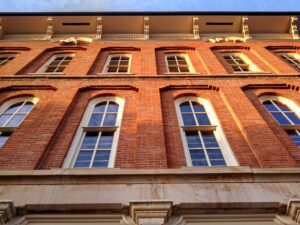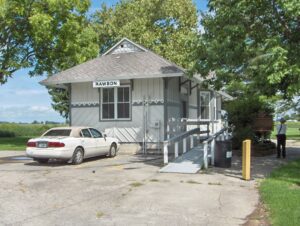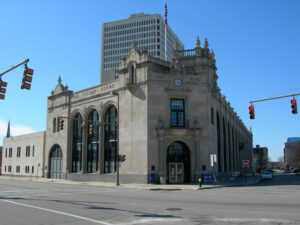, OH
Manchester was founded in 1791 by Nathaniel Massie as a base to survey the land warrants of American Revolutionary War soldiers in the Virginia Military District. This bank of the Ohio River provided a secure site for the last civilian stockade built in Ohio. The natural protection of this fortification included marshland to the west and north and the river on the south. The nearby three islands provided a safe place for retreat in dangerous circumstances and also supplied an area to raise food in its rich bottomlands. The invention of the steam powered paddle wheel boat allowed the river to become the city’s main source of shipping and commerce in the nineteenth century. Manchester was an important port of call for provisions; the export of agricultural products; and the manufacture of goods such as pottery, furniture, and leather goods.
, OH
In 1810, Dr. Oliver Bigelow from Lansing, New York purchased a 4,000 acre tract of land in Monroe Township for $10,000. Dr. Bigelow planned to build a town. After mapping out streets, the town square, and a cemetery, he named the village Johnstown. Dr. Bigelow was the town’s first medical doctor and the first mayor. He died on November 5, 1817 and was buried in Bigelow Cemetery. Located in the southwest corner of the village, the cemetery became the resting place for more than 275 early residents as well as veterans of three wars. Their grave markers, though weathered by the seasons, serve as a reminder of their great contributions to their community and the nation.
, OH
Ottawa Park, the largest city park, was developed in the early 1890s on the 280-acre farm of John B. Ketcham. Based on a design by the famous landscape architect, Frederick Law Olmsted, Ottawa Park was intended to be central to a vast park and boulevard system. By 1920 the Toledo Park movement had provided fifteen parks totaling nearly 1400 acres.
, OH
Marion civic leaders Shauck Elah Barlow and Ida Harsh Barlow built “Waldheim,” their Colonial Revival residence, between 1903-1905. Ida Barlow, then president of the Marion Women’s Club, hosted a December 1905 meeting in her new home. Members discussed art, music, literature, and ideas for “civic improvement.” In 1909, this and other Marion clubs reorganized as the Marion County Federation of Women’s Clubs. Federation members soon organized into action: providing college loans to young women; sponsoring visiting city and later school nurses; purchasing trash receptacles; providing dental clinics for low-income residents; and funding railroad crossing safety equipment. Upon her death in 1945, Barlow bequeathed her house to the Federation as the “Women’s Club Home.” The new Federation headquarters offered meeting space for the Executive Board and the many associated clubs. (Continued on other side)
, OH
Pioneers began to settle in the Groveport area around the year 1800. Subsequent growth was spurred by the opening of the Ohio Erie Canal, and, in 1847, the adjacent settlements of Rarey’s Port and Wert’s Grove merged to form the village of Groveport. The canal, which crossed Main Street immediately east of this marker, declined in importance as a commercial lifeline with the local arrival in 1868 of the faster and more flexible railroad system. By 1900, boat traffic on the canal ceased entirely. Traces of the canal bed are still visible throughout the area.
, OH
Rufus P. Stone, grandson of General Rufus Putnam, settled on this 1,000 acre farm and built a wooden farmhouse here in 1818. In 1855, John E. Thomas purchased the original farmhouse and 600 acres from the heirs of Rufus P. Stone. Thomas enlarged the farmhouse into the present manor house with a large sandstone addition in 1857. The farm was known for its extensive orchards and fine livestock, including cattle, sheep, and high quality saddle horses. Thomas, dressed in silk hat, frock coat, and all the finery of the day, rode one of his fine saddle horses around the estate supervising farm laborers. He developed an enclosed nature preserve on the farm for breeding and raising deer that were nearly extinct in Ohio in the 1850s. Thomas later acquired 200 more acres of the original acres for a total of 800 acres.
, OH
The original town plat of Rawson was filed on February 3, 1855, consisting of fifty-five lots in sections 13 and 14 of Union Township, Hancock County on the Frederick Keller and George J. Kelly farms. Several residential and business structures were built in anticipation of completion of a railroad rumored to pass from Fremont through the “Rawson” area on its way to the western boundary of Ohio. Farmers Keller and Kelly named their village Rawson after L.Q. Rawson, President of the railroad company, hoping that the name would encourage him to build through their area. Financial troubles delayed construction causing a standstill in Rawson. Seventeen years later the first locomotive arrived in Rawson, spurring new construction. At that time the railroad was called the Lake Erie and Louisville; in 1879 it was changed to the Lake Erie and Western and in 1922 became part of the Nickel Plate Railroad. (Continued on other side)
, OH
The Toledo Blade is the city’s oldest continuing business. The newspaper was first published on December 19, 1835, during the Ohio-Michigan boundary dispute known as the “Toledo War.” The name is derived from that conflict and the famous swords of Toledo, Spain. A copy of the first edition and two gift swords from that Spanish city are displayed inside the Blade Building.


